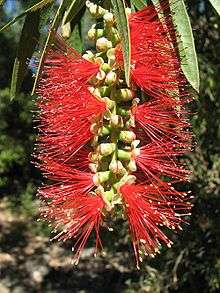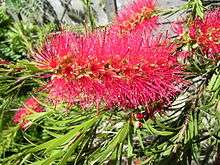Callistemon
| Bottlebrushes | |
|---|---|
 | |
| Red bottlebrush flower | |
| Scientific classification | |
| Kingdom: | Plantae |
| (unranked): | Angiosperms |
| (unranked): | Eudicots |
| (unranked): | Rosids |
| Order: | Myrtales |
| Family: | Myrtaceae |
| Subfamily: | Myrtoideae |
| Tribe: | Melaleuceae |
| Genus: | Callistemon R.Br.[1] |
Callistemon /ˌkælᵻˈstiːmən/[2] is a genus of shrubs in the family Myrtaceae, first described as a genus in 1814.[3] The entire genus is endemic to Australia but widely cultivated in many other regions and naturalised in scattered locations.[4] Their status as a separate taxon is in doubt, some authorities accepting that the difference between callistemons and melaleucas is not sufficient for them to be grouped in a separate genus.
Description
Callistemon species have commonly been referred to as bottlebrushes because of their cylindrical, brush like flowers resembling a traditional bottle brush. They are mostly found in the more temperate regions of Australia, especially along the east coast and typically favour moist conditions so when planted in gardens thrive on regular watering. However, two species are found in Tasmania and several others in the south-west of Western Australia. At least some species are drought-resistant and some are used in ornamental landscaping elsewhere in the world.


Taxonomy
The genus Callistemon was first formally described in 1814 by Robert Brown.[5] In his description he noted that the genus includes “those species of Metrosideros that have inflorescence similar to that of Melaleuca, and distinct elongated filaments.”[5] Carl Linnaeus had described the genus Melaleuca in 1767[6] and in 1867, George Bentham brought all the Metrosideros species into Melaleuca. Bentham described melaleucas as having stamens united in bundles opposite the (five) petals.[7]
In his 1864 description of Callistemon salignus in Fragmenta phytographiae Australiae, Ferdinand von Mueller noted that the difference between the genera was “entirely artificial” (“omnino artificiale").[8] George Bentham also noted in Flora Australiensis that Callistemon “passes gradually into Melaleuca, with which F. Mueller proposes to unite it.”[9] In 1876, Henri Ernest Baillon proposed in Histoire des Plantes that Callistemon, as well as Calothamnus and Lamarchea be merged into Melaleuca.[10]
Nevertheless, most authors had preserved the distinction between the two genera Callistemon and Melaleuca until 1998. In that year, in recognition of the fact that the callistemons and melaleucas on New Caledonia were clearly related, Lyndley Craven and J.W. Dawson transferred the callistemons on that island to Melaleuca, even though some (eg. Melaleuca pancheri) do not have stamens fused in 5 groups.[11]
On the basis of DNA evidence,[12] in 2006[13] and 2009[14] Craven moved all but four callistemons to melaleuca. Those four were Callistemon forresterae, Callistemon genofluvialis, Callistemon kenmorrisonii and Callistemon nyallingensis which were regarded as being hybrids.[11]
The new description of Melaleuca has been accepted by some herbaria but not all. For example, the Queensland Herbarium accepts Melaleuca flammea (synonym Callistemon acuminatus)[15] but the New South Wales Herbarium accepts Callistemon acuminatus.[16] In 2012, Frank Udovicic and Roger Spencer transferred the newly described species of melaleuca with separate stamens (eg. Melaleuca megalongensis and Melaleuca wimmerensis) to Callistemon (hence Callistemon megalongensis and Callistemon wimmerensis). Their argument is that using the DNA evidence is premature.[17] They further argue that if all the genera Beaufortia, Callistemon, Calothamnus, Conothamnus, Eremaea, Melaleuca, Phymatocarpus were combined (as Craven has suggested),[18] then there would be no characteristics that would define the group.[19]
Use in horticulture
Many commercial nurseries continue to use the name ‘’Callistemon’’. These species can be propagated either by cuttings (some species more easily than others), or from the seeds.[20] Flowering is normally in spring and early summer (October–December), but conditions may cause flowering at other times of the year. The obvious parts of the flower masses are stamens, with the pollen at the tip of the filament; the petals are inconspicuous (see picture). Flower heads vary in colour with species; most are red, but some are yellow, green, orange or white. Each flower head produces a profusion of triple-celled seed capsules around a stem (see picture) which remain on the plant with the seeds enclosed until stimulated to open when the plant dies or fire causes the release of the seeds. A few species release the seeds annually.[21][22]
Bottlebrush plants can be grown in pots.[23]
They have been grown in Europe since a specimen of Callistemon citrinus was introduced to Kew Gardens in London by Joseph Banks in 1789.[24]
Selected species
There are about 50 species of callistemon.[22] They include:[5]
- Callistemon acuminatus Cheel – Tapering-leaved Bottlebrush (also known as Melaleuca flammea);
- Callistemon brachyandrus Lindl. – Prickly Bottlebrush (also known as Melaleuca brachyandra);
- Callistemon chisholmii Cheel (also known as Melaleuca chisholmii);
- Callistemon citrinus (Curtis) Skeels – Lemon Scented Bottle Brush (also known as Melaleuca citrina);
- Callistemon coccineus F.Muell. (also known as Melaleuca rugulosa);
- Callistemon comboynensis Cheel – Cliff Bottlebrush (also known as Melaleuca comboynensis);
- Callistemon flavovirens (Cheel) Cheel – Green Bottlebrush (also known as Melaleuca flavovirens);
- Callistemon formosus S.T.Blake (also known as Melaleuca formosa);
- Callistemon forresterae Molyneux
- Callistemon genofluvialis Molyneux
- Callistemon glaucus (DC.) Sweet (also known as Melaleuca glauca);
- Callistemon hemistictus (S.T.Blake ex Craven) Udovicic and R.D.Spencer (also known as Melaleuca hemisticta);
- Callistemon kenmorrisonii Molyneux – Betka Bottlebrush
- Callistemon lanceolatus (Sm.) Sweet (also known as Melaleuca citrina);
- Callistemon lazaridis (Craven) Udovicic & R.D.Spencer (also known as Melaleuca lazaridis);
- Callistemon linearifolius (Link) DC. (also known as Melaleuca linearifolia);
- Callistemon linearis Sweet (also known as Melaleuca linearis);
- Callistemon macropunctatus (Dum.Cours.) Court (also known as Melaleuca rugulosa);
- Callistemon megalongensis (Craven & S.M.Douglas) Udovicic & R.D.Spencer (also known as Melaleuca megalongensis);
- Callistemon montanus C.T.White ex S.T.Blake – Mountain Bottlebrush (also known as Melaleuca montana);
- Callistemon montis-zamiae (Craven) Udovicic & R.D.Spencer (also known as Melaleuca montis-zamia);
- Callistemon nervosus Lindl. (also known as Melaleuca nervosa);
- Callistemon nyallingensis Molyneux
- Callistemon pachyphyllus Cheel – Wallum Bottlebrush (also known as Melaleuca pachyphylla);
- Callistemon pallidus (Bonpl.) DC. – Lemon Bottlebrush (also known as Melaleuca pallida);
- Callistemon paludosus F.Muell. (also known as Melaleuca paludicola);
- Callistemon pauciflorus R.D.Spencer & Lumley (also known as Melaleuca faucicola);
- Callistemon pearsonii R.D.Spencer & Lumley (also known as Melaleuca pearsonii);
- Callistemon phoeniceus Lindl. – Lesser Bottlebrush (also known as Melaleuca phoenicea);
- Callistemon phratra (Craven) Udovicic & R.D.Spencer (also known as Melaleuca phratra);
- Callistemon pinifolius (Wendl.) Sweet – Pine-leaved Bottlebrush (also known as Melaleuca linearis);
- Callistemon pityoides F.Muell. – Alpine Bottlebrush (also known as Melaleuca pityoides);
- Callistemon polandii F.M.Bailey (also known as Melaleuca polandii);
- Callistemon pungens Lumley & R.D.Spencer (also known as Melaleuca williamsii);
- Callistemon pyramidalis (Craven) Udovicic & R.D.Spencer (also known as Melaleuca pyramidalis);
- Callistemon quercinus (Craven) Udovicic & R.D.Spencer (also known as Melaleuca quercina);
- Callistemon recurvus R.D.Spencer & Lumley (also known as Melaleuca recurva);
- Callistemon rigidus R.Br. – Stiff Bottlebrush (also known as Melaleuca linearis);
- Callistemon rugulosus (Schltdl. ex Link) DC. – Scarlet Bottlebrush (also known as Melaleuca rugulosa);
- Callistemon sabrina (Craven) Udovicic & R.D.Spencer (also known as Melaleuca sabrina);
- Callistemon salignus (Sm.) Sweet – Willow Bottlebrush, White Bottlebrush (also known as Melaleuca salicina);
- Callistemon serpentinus (Craven) Udovicic & R.D.Spencer (also known as Melaleuca serpentina);
- Callistemon shiressii Blakely (also known as Melaleuca shiressii);
- Callistemon sieberi DC. (also known as Melaleuca paludicola);
- Callistemon speciosus (Sims) Sweet (also known as Melaleuca glauca);
- Callistemon subulatus Cheel (also known as Melaleuca subulata);
- Callistemon teretifolius F.Muell. – Needle Bottlebrush, Flinders Ranges Bottlebrush (also known as Melaleuca orophila);
- Callistemon viminalis (Sol. ex Gaertn.) G.Don – Weeping Bottlebrush (also known as Melaleuca viminalis);
- Callistemon viridiflorus (Sims) Sweet (also known as Melaleuca virens);
- Callistemon wimmerensis Marriott & G.W.Carr (also known as Melaleuca wimmerensis);
Gallery
_bud.jpg) Foreground: Bottlebrush buds. Background: Partial blooming bottlebrush flower.
Foreground: Bottlebrush buds. Background: Partial blooming bottlebrush flower.- Blooming bottlebrush found in Kelantan, Malaysia.
.jpg) Bottlebrush flower partial blooming found in Kelantan, Malaysia.
Bottlebrush flower partial blooming found in Kelantan, Malaysia. Tree in bloom in Florida.
Tree in bloom in Florida. Illustration showing bottle brushes, the namesake of the plant
Illustration showing bottle brushes, the namesake of the plant
See also
References
| Wikimedia Commons has media related to Callistemon. |
| Wikispecies has information related to: Callistemon |
- ↑ "Genus: Callistemon R. Br.". Germplasm Resources Information Network. United States Department of Agriculture. 2009-01-27. Retrieved 2010-04-21.
- ↑ Sunset Western Garden Book, 1995:606–607
- ↑ Brown, Robert. 1814. Voyage to Terra Australis 2(App. 3): 547
- ↑ Kew World Checklist of Selected Plant Families
- 1 2 3 "Callistemon R.Br.'". APNI. Retrieved 22 July 2015.
- ↑ "Melaleuca R.Br.'". APNI. Retrieved 22 July 2015.
- ↑ Bentham, George; von Mueller, Ferdinand (1866). Fragmenta Phytographiae Australiae. London: Lovell, Reeve and Co. pp. 123–163. Retrieved 22 July 2015.
- ↑ von Mueller, Ferdinand (1864). Fragmenta Phytographiae Australiae (Volume 4). Melbourne. p. 55. Retrieved 22 July 2015.
- ↑ Bentham, George; von Mueller, Ferdinand (1866). Fragmenta Phytographiae Australiae. London: Lovell, Reeve and Co. p. 55. Retrieved 22 July 2015.
- ↑ Baillon, Henri Ernest (1876). Histoires des Plantes. Paris: Libraire Hachette & Co. pp. 359–360. Retrieved 22 July 2015.
- 1 2 Brophy, Joseph J.; Craven, Lyndley A.; Doran, John C. (2013). Melaleucas : their botany, essential oils and uses (PDF). Canberra: Australian Centre for International Agricultural Research. p. 18. ISBN 9781922137517. Retrieved 22 July 2015.
- ↑ Edwards, Robert D.; Craven, Lyn A.; Crisp, Michael D.; Cook, Lyn G. (2010). "Melaleuca revisited: cpDNA and morphological data confirm that Melaleuca L. (Myrtaceae) is not monophyletic". Taxon. 59 (3): 744–754. Retrieved 22 July 2015.
- ↑ Craven, Lyn A. (2006). "New combinations in Melaleuca for Australian species of Callistemon (Myrtaceae)". Novon. 16 (4): 468–478. doi:10.3417/1055-3177(2006)16[468:ncimfa]2.0.co;2. Retrieved 22 July 2015.
- ↑ Craven, Lyn A. (10 December 2009). "Melaleuca (Myrtaceae) from Australia". Novon: A Journal for Botanical Nomenclature. 19 (4): 444–453. doi:10.3417/2007137. Retrieved 22 July 2015.
- ↑ "Species profile—Melaleuca flammea". Queensland Government. Retrieved 22 July 2015.
- ↑ Spencer, Roger David; Lumley, Peter F. "Callistemon acuminatus Cheel". Royal Botanic Garden Sydney: Plantnet. Retrieved 22 July 2015.
- ↑ Brown, Gillian K.; Udovicic, Frank; Ladiges, Pauline Y. (2001). "Molecular phylogeny and biogeography of Melaleuca, Callistemon and related genera (Myrtaceae)". Australian Systematic Botany. 14 (4): 565–585. doi:10.1071/SB00029.
- ↑ Craven, Lyn A.; Edwards, Robert D.; Cowley, Kirsten J. (30 June 2014). "New combinations and names in Melaleuca (Myrtaceae)". Taxon. 63 (3): 663–670. doi:10.12705/633.38. Retrieved 22 July 2015.
- ↑ Udovicic, Frank; Spencer, Roger David (2012). "New combinations in Callistemon (Myrtaceae)" (PDF). Muelleria. 30 (1): 23–25. Retrieved 22 July 2015.
- ↑ Williams, Bryon. "Growing Callistemon from Seed". Australian Native Plants Society Australia. Retrieved 22 July 2015.
- ↑ Wrigley, John W.; Fagg, Murray (1983). Australian native plants : a manual for their propagation, cultivation and use in landscaping (2nd ed.). Sydney: Collins. pp. 191–194. ISBN 0002165759.
- 1 2 Harvey, Rod. "Bottlebrush - Genus Callistemon". Australian National Botanic Garden. Retrieved 22 July 2015.
- ↑ Williams, Bryon. "Growing Callistemons in large pots". Australian Native Plants Society Australia. Retrieved 22 July 2015.
- ↑ Curtis, William (1794). The Botanical Magazine (Volume 8) (1 ed.). London. p. 260. Retrieved 22 July 2015.
- "Callistemon". Australian Plant Name Index (APNI), IBIS database. Centre for Plant Biodiversity Research, Australian Government, Canberra. Retrieved 2007-11-19.


